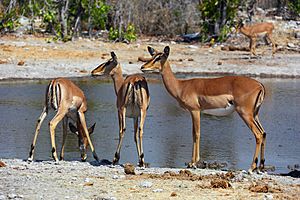Watering hole facts for kids
A watering hole is a natural dip in the land where water collects. It often forms a small pond or a tiny lake. These special places are vital for many living things, especially in dry areas. They provide essential water for animals, plants, and even people.
Contents
What is a Watering Hole?
A watering hole is simply a low area in the ground that fills with water. Think of it as a natural bowl in the earth. These water sources are super important for wildlife and human communities, especially where water is scarce.
Natural Watering Holes: Temporary or Permanent
Some watering holes are only around for a short time. We call these temporary or ephemeral waterholes. They might appear after heavy rain and then dry up. Others are seasonal, meaning they show up during certain times of the year. Then there are permanent watering holes. These stay full of water all year long. Their existence often depends on the climate and if they are fed by groundwater.
Watering Holes in Australia: Billabongs and Deserts
In Australia, a special type of watering hole is called a "billabong". A billabong is often a U-shaped pond. It forms when a river changes its path, leaving behind a loop of water. Billabongs and other watering holes are incredibly important in Australia's deserts. They are often the only water source for native animals, people, and livestock. These spots also provide homes for many different plant and animal species. Sadly, changes in our climate are threatening some of these vital water sources.
How Elephants Help Create Water Sources
Did you know that elephants can help create watering holes? They sometimes dig into termite mounds to find nutrients in the soil. If they keep digging in the same spot, they can create a large dip. This dip can then fill with water, forming a new watering hole!
Human-Made Watering Holes: Helping Wildlife
Sometimes, humans create their own watering holes. These are called artificial watering holes. They are often built in places where natural water is hard to find. These human-made spots can be a big help for wildlife.
Why We Build Artificial Waterholes
Artificial watering holes usually get their water from underground water sources. This water is pumped to the surface. They help animals survive during dry seasons. When natural water sources dry up, these human-made ones become lifesavers. They can also help reduce conflicts between humans and animals. Animals might not wander into human areas looking for water if they have a reliable source.
Watering Holes for Wildlife Watching
Some artificial watering holes are built large enough for animals to bathe in. Because these waterholes are permanent, they become popular spots for tourists. People love to watch wildlife gather there. Some even have lodges or live streaming cameras nearby. This allows people to observe animals without disturbing them.
Animals and Watering Holes: A Gathering Place
Watering holes are busy places in the wild. Many animals, from tiny birds to huge elephants, gather there to drink. It's a central meeting point for different species.
The Truth About Predators and Prey
You might have heard stories, like in The Jungle Book, about a "truce" at watering holes. This idea suggests that predators won't attack prey animals while they are drinking. However, this is a common misconception. In reality, predators like lions often use watering holes to their advantage. They might hide in tall grass nearby. This allows them to ambush unsuspecting prey as they come to drink. So, while animals share the water, the rules of the wild still apply.
Staying Healthy at Watering Holes
When many animals gather in one place, there's a chance for germs to spread. A study showed that animals use watering holes more when water is scarce. This means more animals are crowded together. This crowding can sometimes lead to the spread of illnesses among different species. Keeping water sources clean and healthy is important for everyone.


